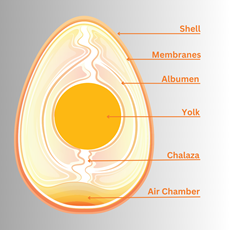Egg-celent Egg Science
What's in an egg?
April 17, 2023
by Carl Nelson, Chief Scientist, Imagination Station

An egg is an incredible bundle of biological science. Each of its components has unique properties and functions, from the shell to the yolk. Let's break down the science of each part.
The hard protective shell of an egg is primarily composed of calcium carbonate. This is the same mineral that makes up limestone and chalk. The color of an egg's shell is determined by the breed of the chicken that lays it. It has no impact on the nutritional value or taste of the egg. The differences are purely cosmetic.
Just under the shell are two thin, transparent membranes. These act as a barrier that protects the egg from bacteria and other contaminants. It also helps to regulate the exchange of gases, allowing oxygen to enter the egg and carbon dioxide to escape.
Egg whites, also known as albumen, are the clear, viscous liquid surrounding the egg yolk in a raw egg. They comprise about 2/3 of the egg's total weight and are rich in protein, vitamins and minerals.
The whites are unique in their ability to foam due to the presence of proteins that can form a network of tiny air bubbles. As you whip the egg whites, the proteins in the whites unfold and form a network of tiny air bubbles. The air bubbles become trapped within this network, causing the egg whites to expand and increase in volume. The proteins then bond together to create a stable foam, which can be used in various recipes.
At the center of the egg is the yolk. It's held in place by the chalaza. This rope-like structure anchors the yolk to the egg white. It helps to keep the yolk in place and prevents it from moving around too much.
Egg yolk is a natural emulsifier due to its high content of lecithin, a type of phospholipid, or compound that can help to blend together oil and water-based liquids. When egg yolk is mixed with oil and an acidic ingredient (such as vinegar or lemon juice), it forms a stable emulsion known as a mayonnaise or hollandaise sauce.
The gray or greenish color that sometimes appears on the surface of a hard-boiled egg yolk results from a chemical reaction between the sulfur in the egg white and the iron in the egg yolk. This reaction is more likely to occur in older eggs or eggs cooked at too high a temperature or too long.
Overall, an egg is a complex and fascinating structure that contains various components with unique properties and functions. Each part of the egg protects and nourishes the developing embryo and provides nutrients for human consumption.